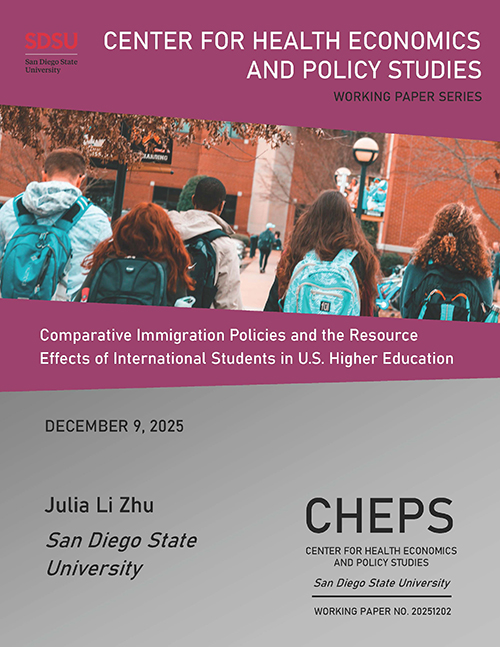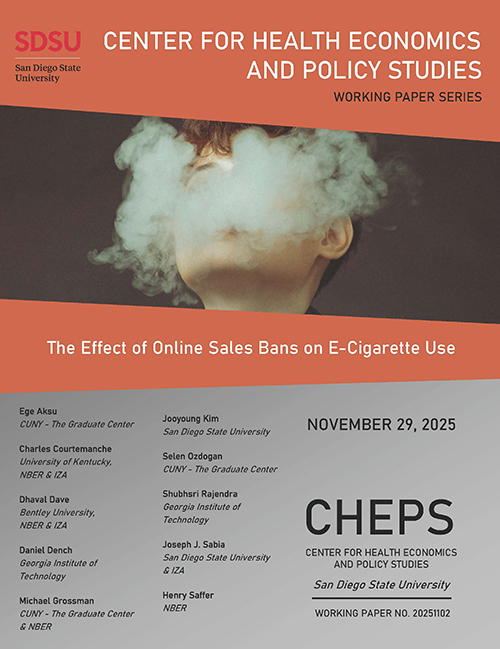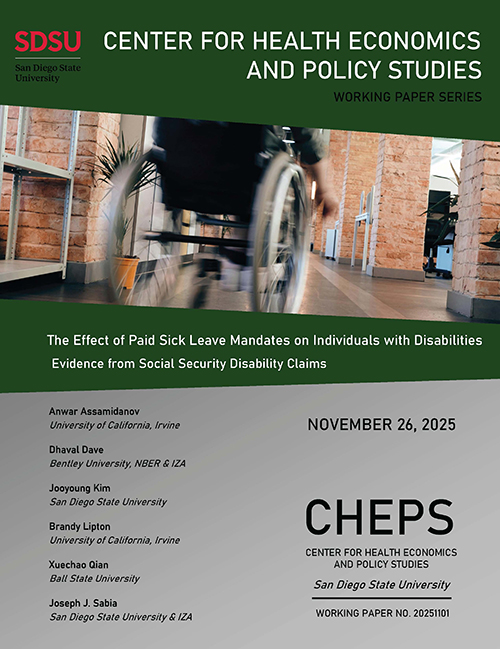
Welcome from the Director
 The Center for Health Economics & Policy Studies (CHEPS) is an interdisciplinary research
center that supports impactful, policy relevant scholarship in the areas of health
economics and social policy analysis. Housed in the College of Arts & Letters, CHEPS
brings together faculty and graduate students engaged in complementary research in
the areas of national defense policy, economic demography, the economics of crime
and punishment, and the economics of risky health behaviors. Read more>>
The Center for Health Economics & Policy Studies (CHEPS) is an interdisciplinary research
center that supports impactful, policy relevant scholarship in the areas of health
economics and social policy analysis. Housed in the College of Arts & Letters, CHEPS
brings together faculty and graduate students engaged in complementary research in
the areas of national defense policy, economic demography, the economics of crime
and punishment, and the economics of risky health behaviors. Read more>>
Read the CHEPS Magazine 2025
Past issues of the magazine: 2024 | 2023 | 2022 | 2021 | 2020 | 2019 | 2018
CHEPS Pioneering Research
Featured Research
 Nicotine Vaping and Mental Health
Nicotine Vaping and Mental Health
Some tobacco control advocates claim that the growing U.S. youth mental health crisis and high rates of youth electronic nicotine delivery systems (ENDS) use may be causally linked. Some groups, such as Truth Initiative, have suggested that the adoption of policies designed to curb youth ENDS use, through measures such as higher taxes, might also improve teen and young adult mental health. A new study by Chad Cotti, Tessie Krishna, Johanna Catherine Maclean, Erik Nesson, and Joseph J. Sabia investigates this claim using three major national datasets: the Youth Risk Behavior Survey (YRBS), the Behavioral Risk Factor Surveillance System (BRFSS), and the Population Assessment of Tobacco and Health (PATH).
The researchers examine how U.S. ENDS regulations — including taxes, purchase age laws, online sales restrictions, and indoor vaping bans — affected youth mental health. They use a difference-in-differences approach with two-way fixed effects to estimate causal impacts on indicators such as depressive symptoms, suicide ideation, and suicide attempts among high schoolers, as well as poor mental health days among young adults aged 18–24.
The results are consistent and clear: ENDS taxes have no statistically or economically meaningful effects on youth mental health. These findings remain robust across data sources, years, and model specifications. Similar results hold for young adults, where the mental health effects of ENDS taxes are small, inconsistent, and sensitive to analytical choices. They also find that this “null” result largely extends to other U.S. ENDS regulations that restrict access to e-cigarettes.
The authors reconcile their findings with those of the prior public health literature, which found evidence of a positive correlation between nicotine vaping and adverse mental health. They argue that the prior public health literature may have been documenting either “reverse causality” (whereby youths’ mental health affected their vaping behavior) or a “difficult-to-measure third factor” associated with both mental health and vaping behavior. For instance, those youths who grow up in more emotionally and financially deprived households may be more likely to both vape nicotine and have symptoms of depression. The authors conclude that policymakers concerned about adolescent wellbeing may need to look beyond vaping regulations and invest more directly in expanding access to mental health services.
Alcohol Exclusion Provisions in Health Insurance and Ex-Ante Moral Hazard

Alcohol misuse remains a major public health and economic concern in the United States. Between 2015 and 2019, excessive alcohol use contributed to over 140,000 deaths and $340 billion in annual costs, including healthcare, crime, lost productivity, and traffic accidents.
To discourage risky drinking, 16 states implemented Alcohol Exclusion Provisions (AEPs), laws that allowed private insurers to deny claims for injuries sustained while under the influence. The idea was to deter dangerous behavior through financial penalties. However, over time, these laws backfired. Evidence showed AEPs failed to reduce problem drinking and created unintended barriers in medical settings. Fearing claim denials, physicians often avoided alcohol screening or referrals, contradicting federal health guidelines that emphasize early detection and treatment of substance use.
Recognizing these flaws, health organizations like the NAIC and APHA called for change. Since 2000, 16 states have repealed AEPs and replaced them with PDHIAs—laws that prevent insurers from denying coverage for alcohol-related injuries. These reforms aim to reduce stigma, improve care access, and support recovery.
Still, some critics warned of potential “ex-ante moral hazard,” where removing financial risk might encourage more dangerous drinking. Others believed PDHIAs might lead to better outcomes by empowering providers to intervene without penalty.
To test these theories, Baris Yoruk, Dhaval Dave, Tessie Krishna, and Joseph Sabia conducted the first nationwide study of PDHIAs. Analyzing alcohol consumption, crime, traffic deaths, insurance coverage, and premiums, they found no increase in risky behavior or insurance costs. In fact, the study observed modest improvements in some problem behaviors, hinting at better treatment access and reduced stigma.
The bottom line: AEPs didn’t curb drinking and discouraged care. PDHIAs, in contrast, offer a more supportive path, balancing public health goals with compassion and practical access to treatment.
Did Robots Cause a Crime Wave?
In one of the first large-scale U.S. studies connecting automation and public safety, Professor Yang Liang of San Diego State University investigates an unsettling side effect of technological progress: crime. Co-authored with Professors Joseph J. Sabia and Dhaval M. Dave, the paper explores how exposure to robotics in U.S. manufacturing may unintentionally raise property crime rates.
Using a novel identification strategy that ties U.S. county-level automation trends to robotics adoption in European industries, the authors isolate plausibly exogenous variation in local robotics exposure. Their instrumental variables analysis finds that each additional robot per 1,000 workers led to a 4 to 5% increase in property crime arrests, especially theft and motor vehicle-related offenses. Crucially, the study finds no corresponding rise in violent crime.
What drives this increase in property crime? The authors point to robotics-induced job displacement and earnings losses among low-skilled workers. These labor market shocks were most pronounced during the early 2000s, when automation spread rapidly across the manufacturing sector. A back-of-the-envelope estimate suggests that this robotics expansion contributed to over $322 million in additional crime-related social costs nationwide between 2004 and 2010.
This study does not argue that robotics expansions should be prevented, but the findings of this study suggest important distributional impacts and unintended external costs (in the short run). While robots can boost productivity and long-run growth, they may also impose short-run burdens on displaced workers and their communities.
As artificial intelligence and robotics continue to reshape the workplace, this study offers a timely reminder: technological progress should be accompanied by thoughtful policies that address its unintended human consequences.
Schooling and Youth Crime
While schools are widely regarded as spaces for learning and development, new research by CHEPS affiliates Benjamin Hansen, Kyutaro Matsuzawa, and Joseph Sabia reveals that in-person schooling may also carry unexpected social costs, particularly in the form of increased youth violence. Drawing on data from nationwide crime reports, victimization surveys, and hospital records, the study finds that when K–12 schools resume in-person instruction, incidents of violent crime involving juveniles rise significantly—by as much as 28 percent. Crucially, these increases are not limited to arrest records. The pattern also emerges in self-reported victimization data and assault-related hospital visits, suggesting a genuine escalation in harm rather than changes in law enforcement behavior. To identify causal effects, the authors use anonymized cell phone data to track daily foot traffic to schools across thousands of U.S. counties.
The variation in school reopening timelines—especially during the COVID-19 pandemic—serves as a natural experiment. When schools were closed, youth violence declined sharply. As in-person instruction resumed, violence levels rebounded. The mechanisms appear to reflect both a “concentration effect,” wherein the sheer density of students raises the likelihood of conflict, and the quality of peer interactions, which varies with factors like class size and anti-bullying policies. Indeed, the largest increases in violence occurred in jurisdictions with larger pupil-teacher ratios and weaker bullying prevention laws. Most incidents took place during school hours and on school grounds, peaking around dismissal time. Importantly, the rise was limited to violent offenses; property crime did not increase. This distinction suggests that interpersonal dynamics, rather than opportunity-driven behavior, are at the core of the observed trends.
The authors estimate that full in-person schooling generates approximately $233 million per month in social costs due to juvenile violent crime. While these findings do not argue against the value of in-person education, they underscore the need for targeted school-based interventions to reduce peer conflict and improve safety. Strategic investments in classroom management, student support services, and bullying prevention may help mitigate these unintended consequences while preserving the long-term benefits of education.
More Research
Florida’s approach to juvenile justice has evolved—from the punitive policies of the 1980s to a renewed focus on rehabilitation. A key reform is the Juvenile Civil Citation Program, which diverts first-time misdemeanor offenders away from formal arrest and into community-based interventions. Instead of entering the justice system, eligible youth who admit guilt receive a citation and complete requirements like community service, restitution, or counseling. Upon successful completion, their record is cleared from public view.
In a new study, Tessie Krishna evaluates the program’s effectiveness using administrative data from the Florida Department of Juvenile Justice from 2000 to 2018. The study applies robust methods, including difference-in-differences and instrumental variables, to measure impacts on two-year recidivism rates.
The findings are compelling. Eligible youth in counties with the program were 15 to 57 percent less likely to reoffend. Among those who actually received a citation, recidivism dropped by 32 to 38 percent. The effects were strongest in Miami-Dade County—where 78 percent of eligible youth received citations—compared to under 38 percent statewide. Higher implementation rates were linked to larger reductions in recidivism.
The program not only avoids unnecessary system contact but also enforces accountability. Participants must remain crime-free for a year, and failure to comply can trigger formal processing. This balance of support and structure appears key to its success. Cost savings are another potential benefit. A 2007–2008 Miami-Dade report found that civil citation participants cost far less than those in traditional diversion or detention, suggesting that wider use of the program could reduce system costs significantly.
While long-term outcomes like education and employment remain to be studied, the results suggest that civil citations offer a promising alternative to arrest—reducing recidivism while promoting rehabilitation over punishment.
Over the past 60 years, women’s entry into Western labor markets has profoundly reshaped workplace interactions, coinciding with increased scrutiny of bullying and harassment behaviors. While workplace harassment has been an expanding field of research, real-world causal evidence of disparities in harassment across genders remains limited.
This study, authored by Thiago de Lucena, provides causal evidence of gender-based nonsexual harassment in the workplace by analyzing the treatment of female referees in Brazil’s professional male soccer league. It draws on over 1,200 match reports from the 2017 and 2018 seasons, which marked the first notable increase in female referees in Brazil’s top professional soccer divisions. Given the immense popularity and competitiveness of soccer in Brazil, referees operate under high pressure and scrutiny.
The study leverages the quasirandom assignment of referees to matches and employs fixed effects models to compare harassment faced by female and male referees. It also introduces a simple behavioral model to explore players’ decisions to engage in harassment. Findings reveal that female assistant referees received, on average, 0.365 more disciplinary warnings (yellow cards) per game, about a 65% increase primarily for excessive protesting, compared to their male counterparts.
Importantly, the introduction of Video Assistant Referees (VAR) in 2018 fundamentally altered match dynamics by reducing the uncertainty around referee decisions. This diminished the incentive to protest or harass referees. The data show that harassment disparities fell by nearly 0.5 warnings per game after VAR was implemented, effectively eliminating the gender gap in harassment.
These results suggest that male players’ harassment behavior is largely driven by strategic incentives rather than intrinsic bias or differences in referee performance. The study offers novel evidence on gender dynamics in high-stakes environments and highlights how uncertainty can amplify harassment toward women, potentially contributing to gender gaps in leadership or competitive roles.
As cities across the U.S. reevaluate the role of traffic enforcement in public safety, a new study by Kyutaro Matsuzawa offers timely insights into the effects of limiting pretextual police stops—those initiated for minor infractions with the aim of investigating unrelated criminal activity. Using a policy change implemented by the Los Angeles Police Department (LAPD) in March 2022, Matsuzawa evaluates how restrictions on these stops shaped officer behavior, racial disparities, and public safety outcomes.
The LAPD policy raised the bar for conducting pretextual stops, requiring officers to articulate a clear threat to public safety before pulling drivers over for minor offenses like broken taillights or missing registration stickers. Leveraging a combination of regression discontinuity and synthetic difference-indifferences designs, the study finds that likely pretextual stops dropped by 30%, with no corresponding decline in total stops—suggesting that officers substituted toward other traffic enforcement actions. This shift aligns with multitasking theory in public sector work, where agents respond to shifts in oversight by reallocating effort across tasks.
The policy led to significant reductions in stops involving Black and Hispanic drivers—by 15 to 17% and 10%, respectively—without increasing crime, arrests, or traffic accidents. While the number of searches and contraband findings declined, there was no change in contraband seizures, and seizure rates actually improved. Further, warnings fell while citations rose, hinting at a tradeoff between reduced discretionary stops and stricter traffic enforcement.
These findings suggest that pretextual stop restrictions can reduce racial disparities without compromising public safety. Matsuzawa’s analysis adds nuance to the ongoing debate about policing reform: while officers adapted by shifting their focus, the policy’s targeted constraints improved equity and preserved effectiveness. As other jurisdictions consider similar reforms, Los Angeles may offer a roadmap for balancing public accountability with safety priorities.
This paper, by new U.S. Air Force Academy Professor Alexander Chesney, examines how access to affordable childcare influences workforce retention, specifically within the U.S. military. Using detailed personnel data combined with localized childcare market characteristics, the study provides robust evidence that high childcare costs and limited availability significantly increase the likelihood of military personnel separating from service upon the expiration of their enlistment contracts.
The research leverages the unique personnel assignment system within the military, which assigns members to bases largely independent of personal preference. This creates an ideal setting for identifying the causal impact of childcare costs on retention. The findings show that military parents stationed in high-cost childcare areas are 9% more likely to leave military service compared to non-parents, with the most pronounced effects observed among high-skilled personnel and those in occupations with demanding, inflexible schedules.
Further analysis reveals significant heterogeneity in how childcare constraints affect different groups within the military. Single parents—especially mothers—demonstrate higher sensitivity to childcare costs and availability, facing greater economic pressure and limited flexibility, which drives higher separation rates. Occupational characteristics such as long or irregular working hours, strict deadlines, and limited autonomy further exacerbate the childcare burden, particularly for single-parent households.
This study underscores childcare affordability and accessibility as critical determinants of labor market behavior, highlighting important policy implications for enhancing workforce stability. Suggested policy responses include expanding military-affiliated childcare facilities, increasing targeted childcare subsidies, and establishing partnerships with civilian childcare providers in high-cost regions. These insights contribute to broader discussions on how childcare policies shape employment outcomes and provide actionable guidance for organizations aiming to improve retention among employees with family responsibilities.



